2023 NISSAN LEAF stop start
[x] Cancel search: stop startPage 69 of 612
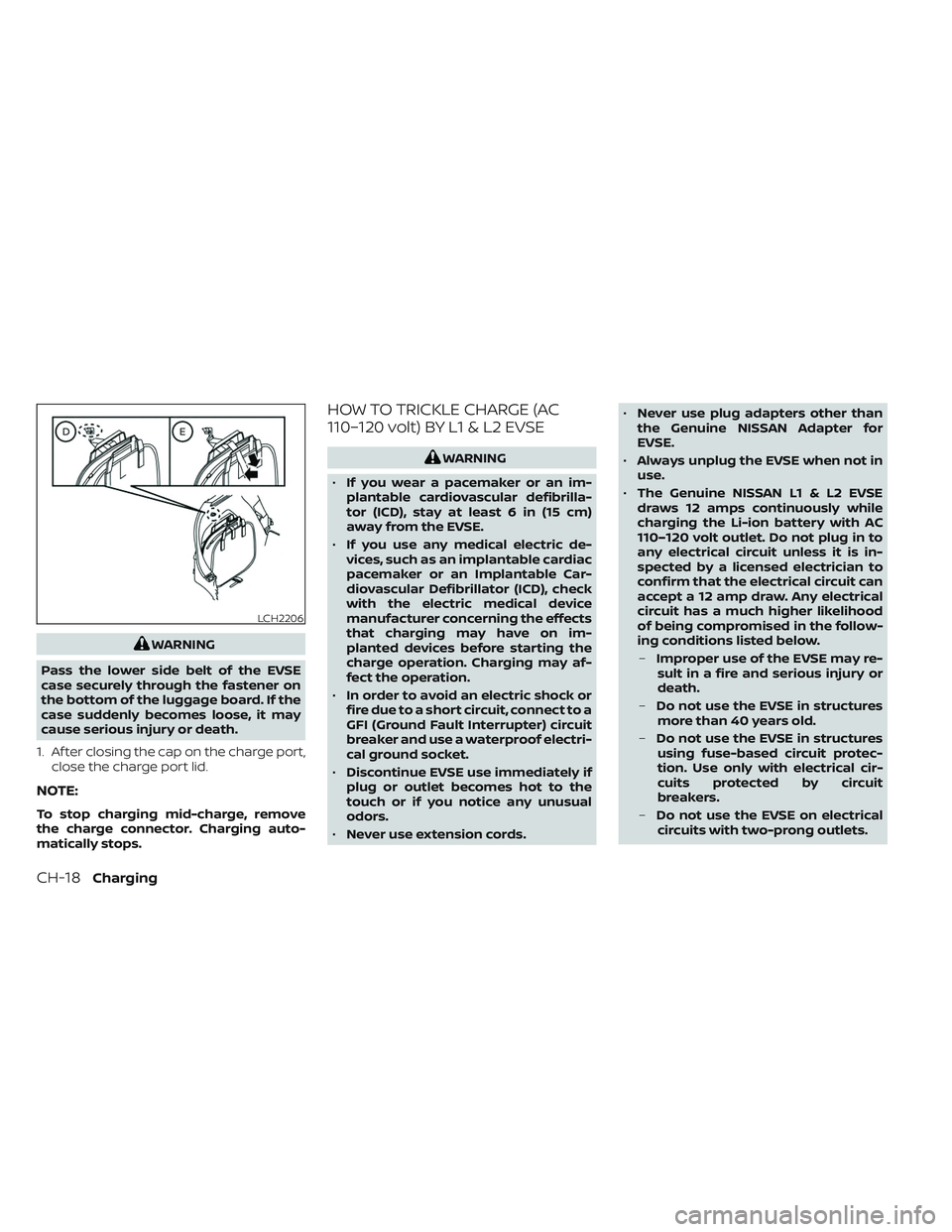
WARNING
Pass the lower side belt of the EVSE
case securely through the fastener on
the bottom of the luggage board. If the
case suddenly becomes loose, it may
cause serious injury or death.
1. Af ter closing the cap on the charge port, close the charge port lid.
NOTE:
To stop charging mid-charge, remove
the charge connector. Charging auto-
matically stops.
HOW TO TRICKLE CHARGE (AC
110–120 volt) BY L1 & L2 EVSE
WARNING
• If you wear a pacemaker or an im-
plantable cardiovascular defibrilla-
tor (ICD), stay at least 6 in (15 cm)
away from the EVSE.
• If you use any medical electric de-
vices, such as an implantable cardiac
pacemaker or an Implantable Car-
diovascular Defibrillator (ICD), check
with the electric medical device
manufacturer concerning the effects
that charging may have on im-
planted devices before starting the
charge operation. Charging may af-
fect the operation.
• In order to avoid an electric shock or
fire due to a short circuit, connect to a
GFI (Ground Fault Interrupter) circuit
breaker and use a waterproof electri-
cal ground socket.
• Discontinue EVSE use immediately if
plug or outlet becomes hot to the
touch or if you notice any unusual
odors.
• Never use extension cords. •
Never use plug adapters other than
the Genuine NISSAN Adapter for
EVSE.
• Always unplug the EVSE when not in
use.
• The Genuine NISSAN L1 & L2 EVSE
draws 12 amps continuously while
charging the Li-ion battery with AC
110–120 volt outlet. Do not plug in to
any electrical circuit unless it is in-
spected by a licensed electrician to
confirm that the electrical circuit can
accept a 12 amp draw. Any electrical
circuit has a much higher likelihood
of being compromised in the follow-
ing conditions listed below.
– Improper use of the EVSE may re-
sult in a fire and serious injury or
death.
– Do not use the EVSE in structures
more than 40 years old.
– Do not use the EVSE in structures
using fuse-based circuit protec-
tion. Use only with electrical cir-
cuits protected by circuit
breakers.
– Do not use the EVSE on electrical
circuits with two-prong outlets.
LCH2206
CH-18Charging
Page 77 of 612
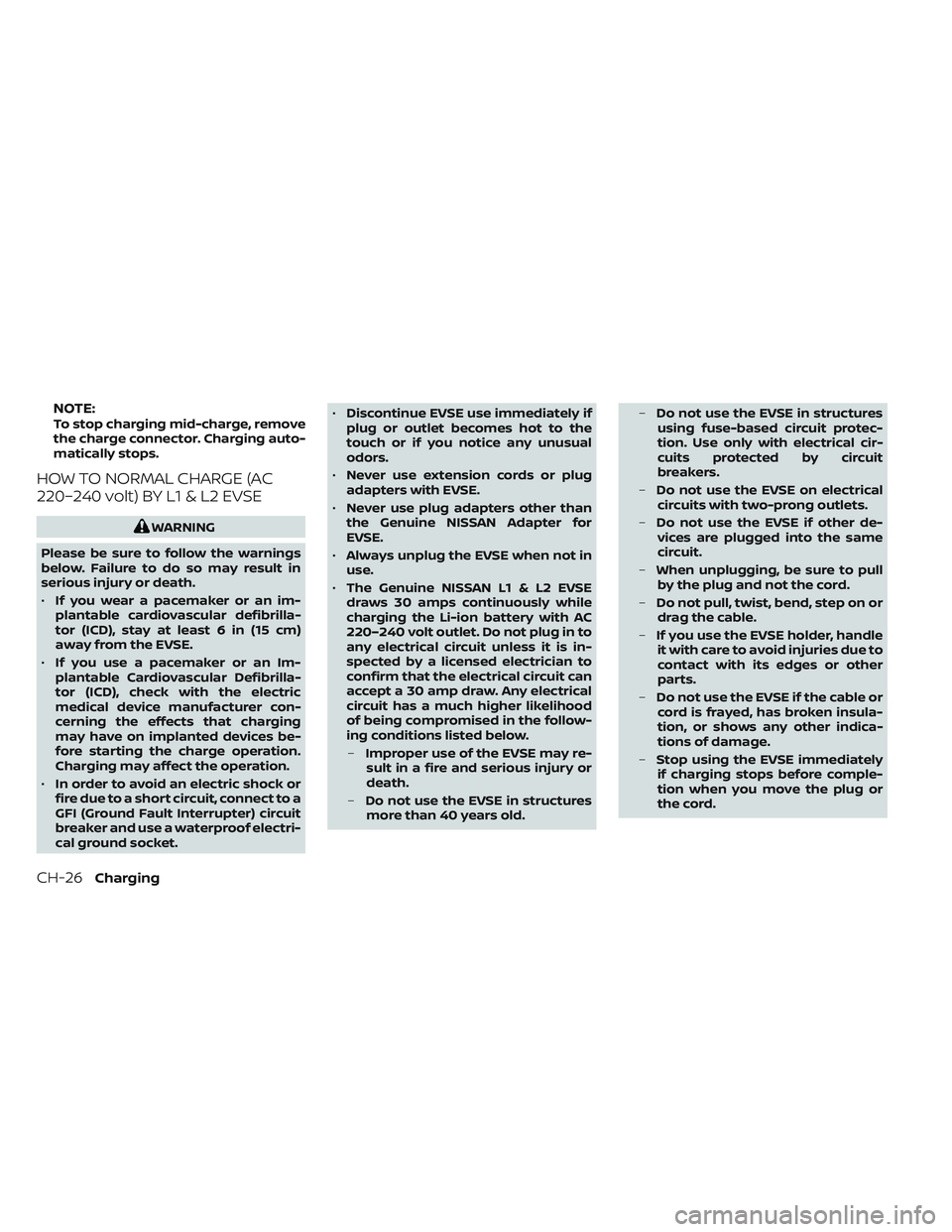
NOTE:To stop charging mid-charge, remove
the charge connector. Charging auto-
matically stops.
HOW TO NORMAL CHARGE (AC
220–240 volt) BY L1 & L2 EVSE
WARNING
Please be sure to follow the warnings
below. Failure to do so may result in
serious injury or death.
• If you wear a pacemaker or an im-
plantable cardiovascular defibrilla-
tor (ICD), stay at least 6 in (15 cm)
away from the EVSE.
• If you use a pacemaker or an Im-
plantable Cardiovascular Defibrilla-
tor (ICD), check with the electric
medical device manufacturer con-
cerning the effects that charging
may have on implanted devices be-
fore starting the charge operation.
Charging may affect the operation.
• In order to avoid an electric shock or
fire due to a short circuit, connect to a
GFI (Ground Fault Interrupter) circuit
breaker and use a waterproof electri-
cal ground socket. •
Discontinue EVSE use immediately if
plug or outlet becomes hot to the
touch or if you notice any unusual
odors.
• Never use extension cords or plug
adapters with EVSE.
• Never use plug adapters other than
the Genuine NISSAN Adapter for
EVSE.
• Always unplug the EVSE when not in
use.
• The Genuine NISSAN L1 & L2 EVSE
draws 30 amps continuously while
charging the Li-ion battery with AC
220–240 volt outlet. Do not plug in to
any electrical circuit unless it is in-
spected by a licensed electrician to
confirm that the electrical circuit can
accept a 30 amp draw. Any electrical
circuit has a much higher likelihood
of being compromised in the follow-
ing conditions listed below.
– Improper use of the EVSE may re-
sult in a fire and serious injury or
death.
– Do not use the EVSE in structures
more than 40 years old. –
Do not use the EVSE in structures
using fuse-based circuit protec-
tion. Use only with electrical cir-
cuits protected by circuit
breakers.
– Do not use the EVSE on electrical
circuits with two-prong outlets.
– Do not use the EVSE if other de-
vices are plugged into the same
circuit.
– When unplugging, be sure to pull
by the plug and not the cord.
– Do not pull, twist, bend, step on or
drag the cable.
– If you use the EVSE holder, handle
it with care to avoid injuries due to
contact with its edges or other
parts.
– Do not use the EVSE if the cable or
cord is frayed, has broken insula-
tion, or shows any other indica-
tions of damage.
– Stop using the EVSE immediately
if charging stops before comple-
tion when you move the plug or
the cord.
CH-26Charging
Page 86 of 612
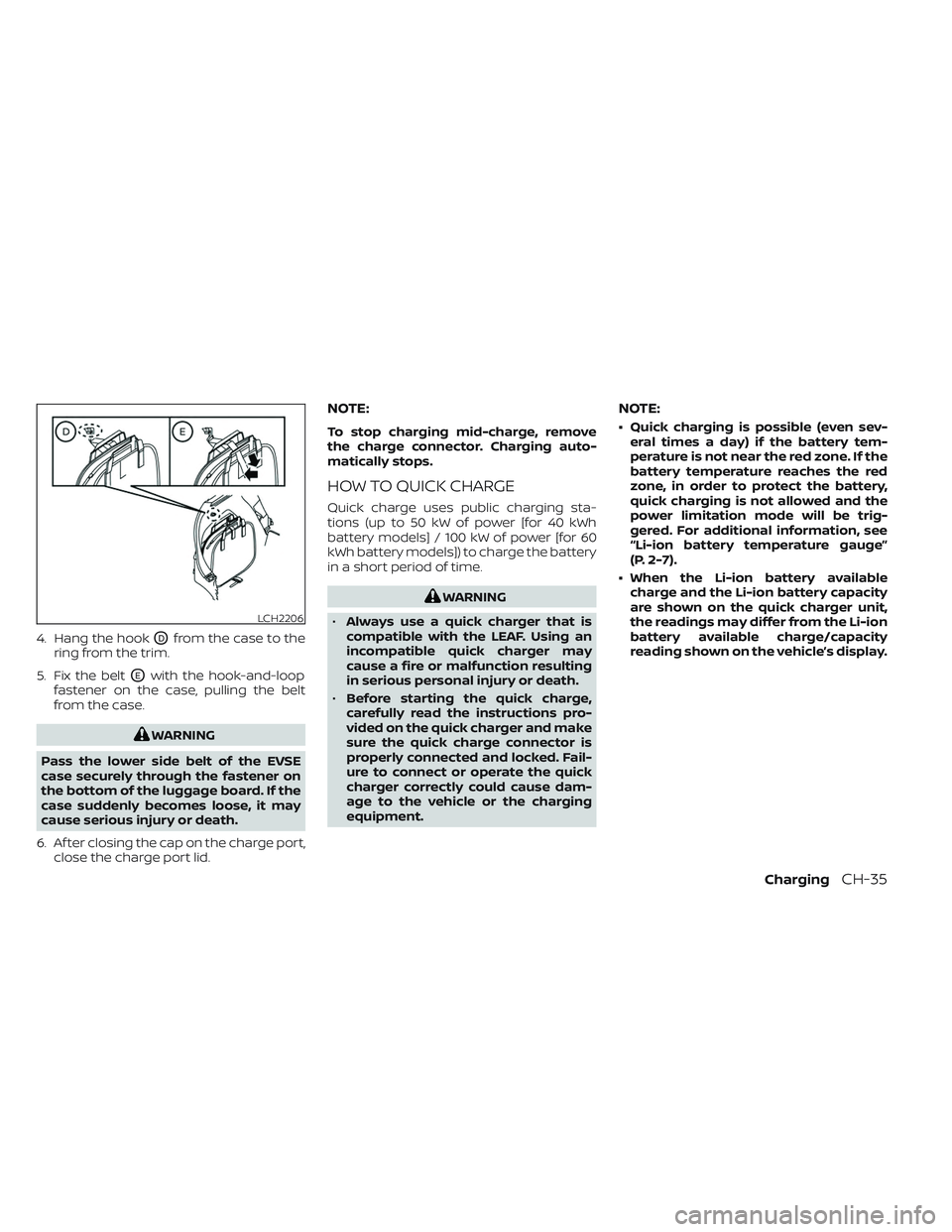
4. Hang the hookODfrom the case to the
ring from the trim.
5. Fix the belt
OEwith the hook-and-loop
fastener on the case, pulling the belt
from the case.
WARNING
Pass the lower side belt of the EVSE
case securely through the fastener on
the bottom of the luggage board. If the
case suddenly becomes loose, it may
cause serious injury or death.
6. Af ter closing the cap on the charge port, close the charge port lid.
NOTE:
To stop charging mid-charge, remove
the charge connector. Charging auto-
matically stops.
HOW TO QUICK CHARGE
Quick charge uses public charging sta-
tions (up to 50 kW of power [for 40 kWh
battery models] / 100 kW of power [for 60
kWh battery models]) to charge the battery
in a short period of time.
WARNING
• Always use a quick charger that is
compatible with the LEAF. Using an
incompatible quick charger may
cause a fire or malfunction resulting
in serious personal injury or death.
• Before starting the quick charge,
carefully read the instructions pro-
vided on the quick charger and make
sure the quick charge connector is
properly connected and locked. Fail-
ure to connect or operate the quick
charger correctly could cause dam-
age to the vehicle or the charging
equipment.
NOTE:
• Quick charging is possible (even sev- eral times a day) if the battery tem-
perature is not near the red zone. If the
battery temperature reaches the red
zone, in order to protect the battery,
quick charging is not allowed and the
power limitation mode will be trig-
gered. For additional information, see
“Li-ion battery temperature gauge”
(P. 2-7).
• When the Li-ion battery available charge and the Li-ion battery capacity
are shown on the quick charger unit,
the readings may differ from the Li-ion
battery available charge/capacity
reading shown on the vehicle’s display.
LCH2206
ChargingCH-35
Page 88 of 612
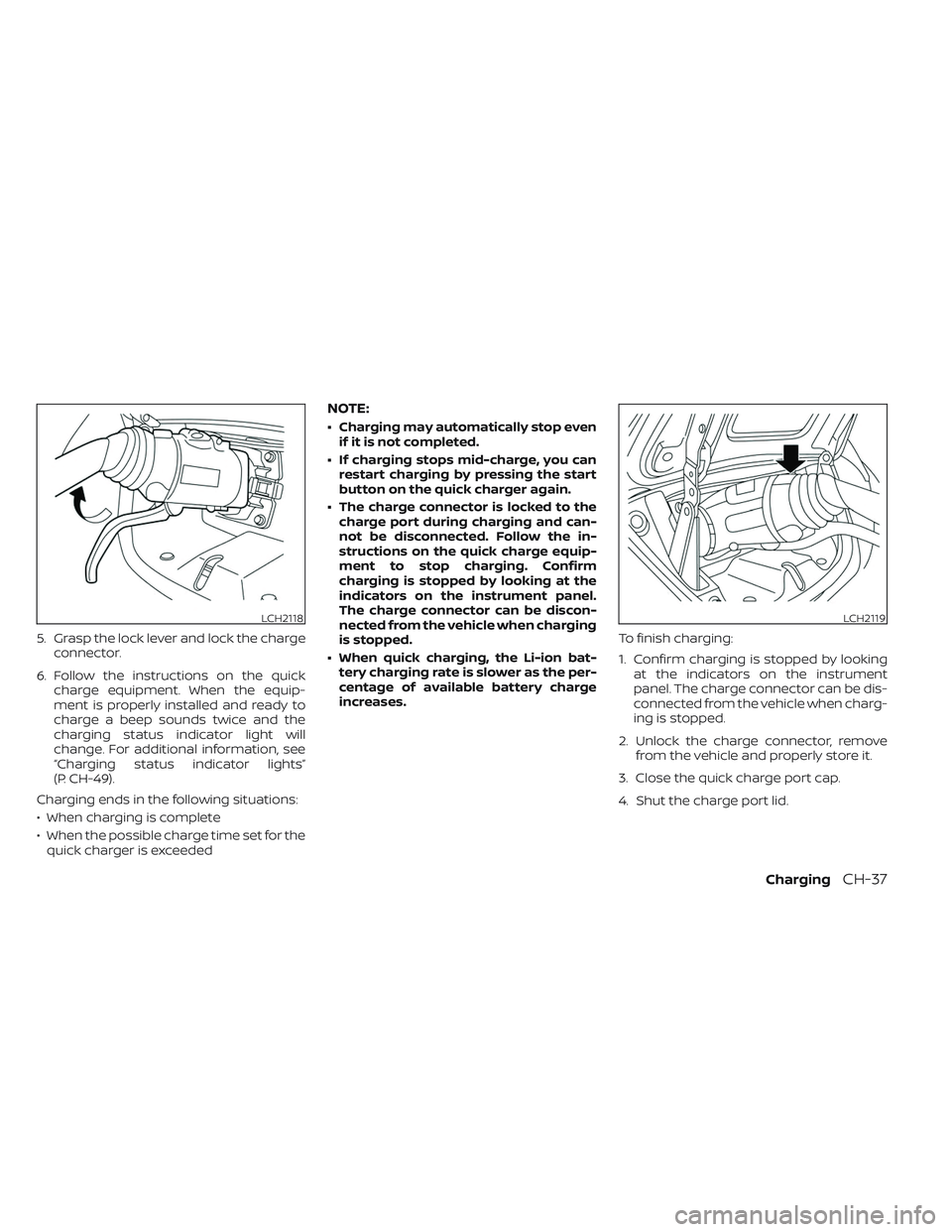
5. Grasp the lock lever and lock the chargeconnector.
6. Follow the instructions on the quick charge equipment. When the equip-
ment is properly installed and ready to
charge a beep sounds twice and the
charging status indicator light will
change. For additional information, see
“Charging status indicator lights”
(P. CH-49).
Charging ends in the following situations:
• When charging is complete
• When the possible charge time set for the quick charger is exceeded
NOTE:
• Charging may automatically stop even if it is not completed.
• If charging stops mid-charge, you can restart charging by pressing the start
button on the quick charger again.
• The charge connector is locked to the charge port during charging and can-
not be disconnected. Follow the in-
structions on the quick charge equip-
ment to stop charging. Confirm
charging is stopped by looking at the
indicators on the instrument panel.
The charge connector can be discon-
nected from the vehicle when charging
is stopped.
• When quick charging, the Li-ion bat- tery charging rate is slower as the per-
centage of available battery charge
increases. To finish charging:
1. Confirm charging is stopped by looking
at the indicators on the instrument
panel. The charge connector can be dis-
connected from the vehicle when charg-
ing is stopped.
2. Unlock the charge connector, remove from the vehicle and properly store it.
3. Close the quick charge port cap.
4. Shut the charge port lid.
LCH2118LCH2119
ChargingCH-37
Page 89 of 612
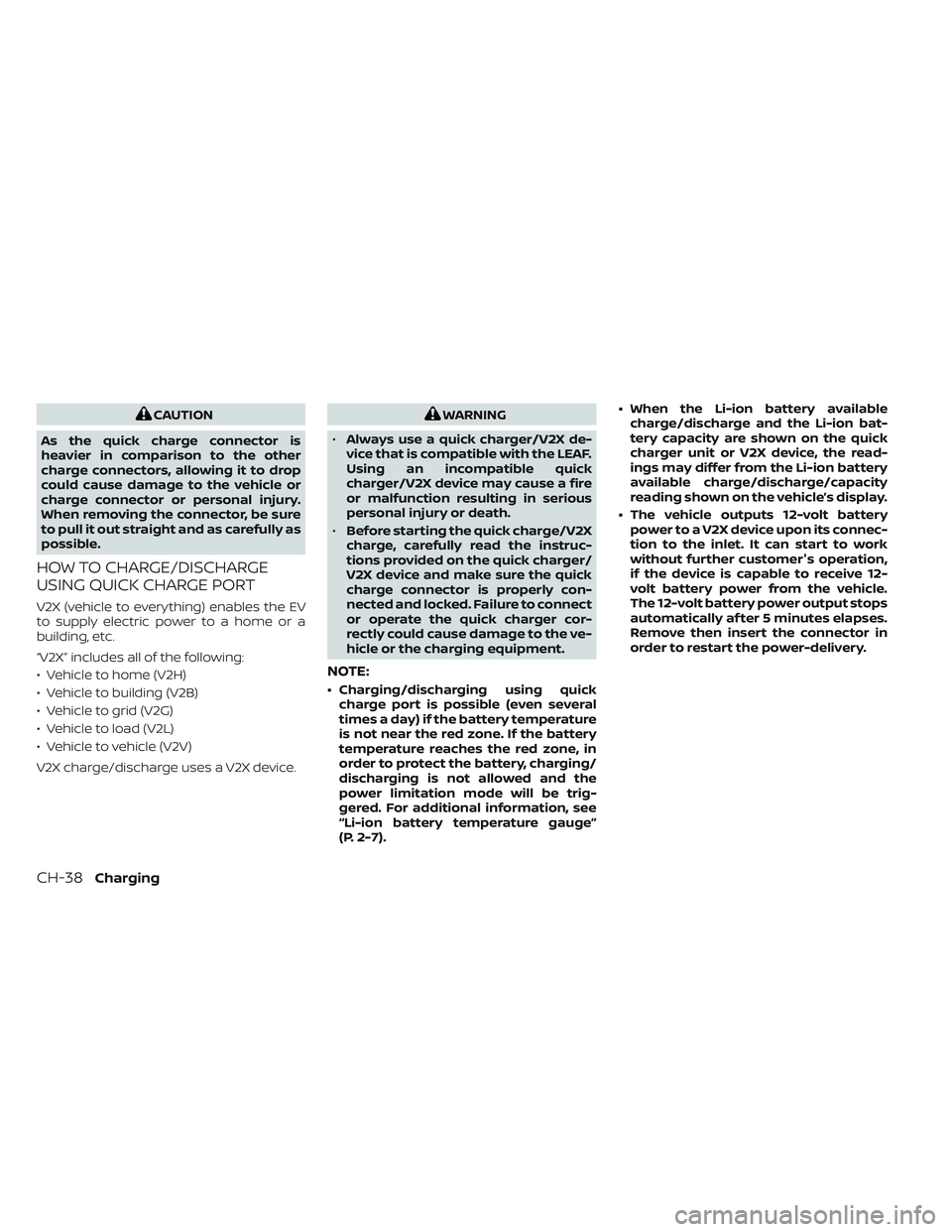
CAUTION
As the quick charge connector is
heavier in comparison to the other
charge connectors, allowing it to drop
could cause damage to the vehicle or
charge connector or personal injury.
When removing the connector, be sure
to pull it out straight and as carefully as
possible.
HOW TO CHARGE/DISCHARGE
USING QUICK CHARGE PORT
V2X (vehicle to everything) enables the EV
to supply electric power to a home or a
building, etc.
“V2X ” includes all of the following:
• Vehicle to home (V2H)
• Vehicle to building (V2B)
• Vehicle to grid (V2G)
• Vehicle to load (V2L)
• Vehicle to vehicle (V2V)
V2X charge/discharge uses a V2X device.
WARNING
• Always use a quick charger/V2X de-
vice that is compatible with the LEAF.
Using an incompatible quick
charger/V2X device may cause a fire
or malfunction resulting in serious
personal injury or death.
• Before starting the quick charge/V2X
charge, carefully read the instruc-
tions provided on the quick charger/
V2X device and make sure the quick
charge connector is properly con-
nected and locked. Failure to connect
or operate the quick charger cor-
rectly could cause damage to the ve-
hicle or the charging equipment.
NOTE:
• Charging/discharging using quick charge port is possible (even several
times a day) if the battery temperature
is not near the red zone. If the battery
temperature reaches the red zone, in
order to protect the battery, charging/
discharging is not allowed and the
power limitation mode will be trig-
gered. For additional information, see
“Li-ion battery temperature gauge”
(P. 2-7). • When the Li-ion battery available
charge/discharge and the Li-ion bat-
tery capacity are shown on the quick
charger unit or V2X device, the read-
ings may differ from the Li-ion battery
available charge/discharge/capacity
reading shown on the vehicle’s display.
• The vehicle outputs 12-volt battery power to a V2X device upon its connec-
tion to the inlet. It can start to work
without further customer's operation,
if the device is capable to receive 12-
volt battery power from the vehicle.
The 12-volt battery power output stops
automatically af ter 5 minutes elapses.
Remove then insert the connector in
order to restart the power-delivery.
CH-38Charging
Page 91 of 612
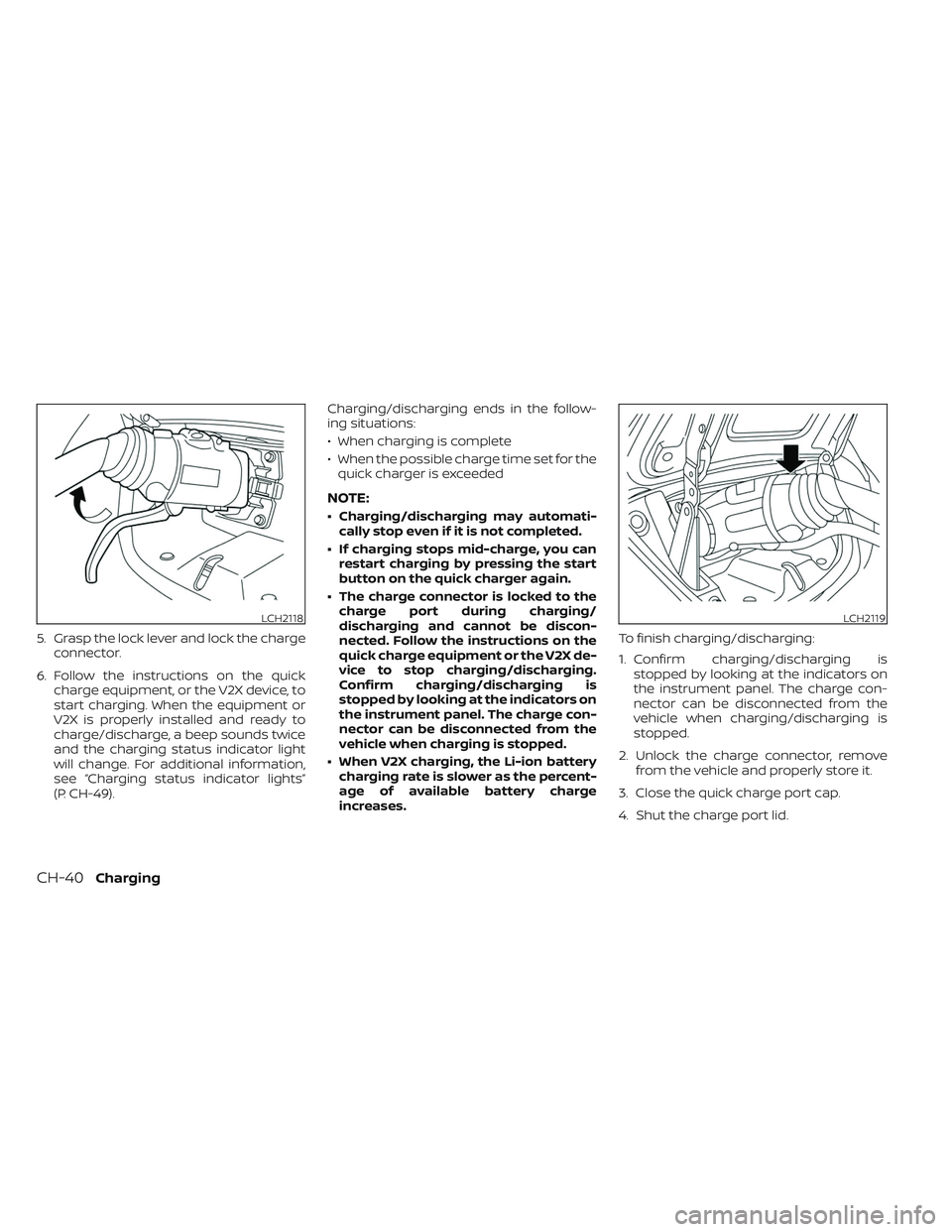
5. Grasp the lock lever and lock the chargeconnector.
6. Follow the instructions on the quick charge equipment, or the V2X device, to
start charging. When the equipment or
V2X is properly installed and ready to
charge/discharge, a beep sounds twice
and the charging status indicator light
will change. For additional information,
see “Charging status indicator lights”
(P. CH-49). Charging/discharging ends in the follow-
ing situations:
• When charging is complete
• When the possible charge time set for the
quick charger is exceeded
NOTE:
• Charging/discharging may automati- cally stop even if it is not completed.
• If charging stops mid-charge, you can restart charging by pressing the start
button on the quick charger again.
• The charge connector is locked to the charge port during charging/
discharging and cannot be discon-
nected. Follow the instructions on the
quick charge equipment or the V2X de-
vice to stop charging/discharging.
Confirm charging/discharging is
stopped by looking at the indicators on
the instrument panel. The charge con-
nector can be disconnected from the
vehicle when charging is stopped.
• When V2X charging, the Li-ion battery charging rate is slower as the percent-
age of available battery charge
increases. To finish charging/discharging:
1. Confirm charging/discharging is
stopped by looking at the indicators on
the instrument panel. The charge con-
nector can be disconnected from the
vehicle when charging/discharging is
stopped.
2. Unlock the charge connector, remove from the vehicle and properly store it.
3. Close the quick charge port cap.
4. Shut the charge port lid.
LCH2118LCH2119
CH-40Charging
Page 108 of 612
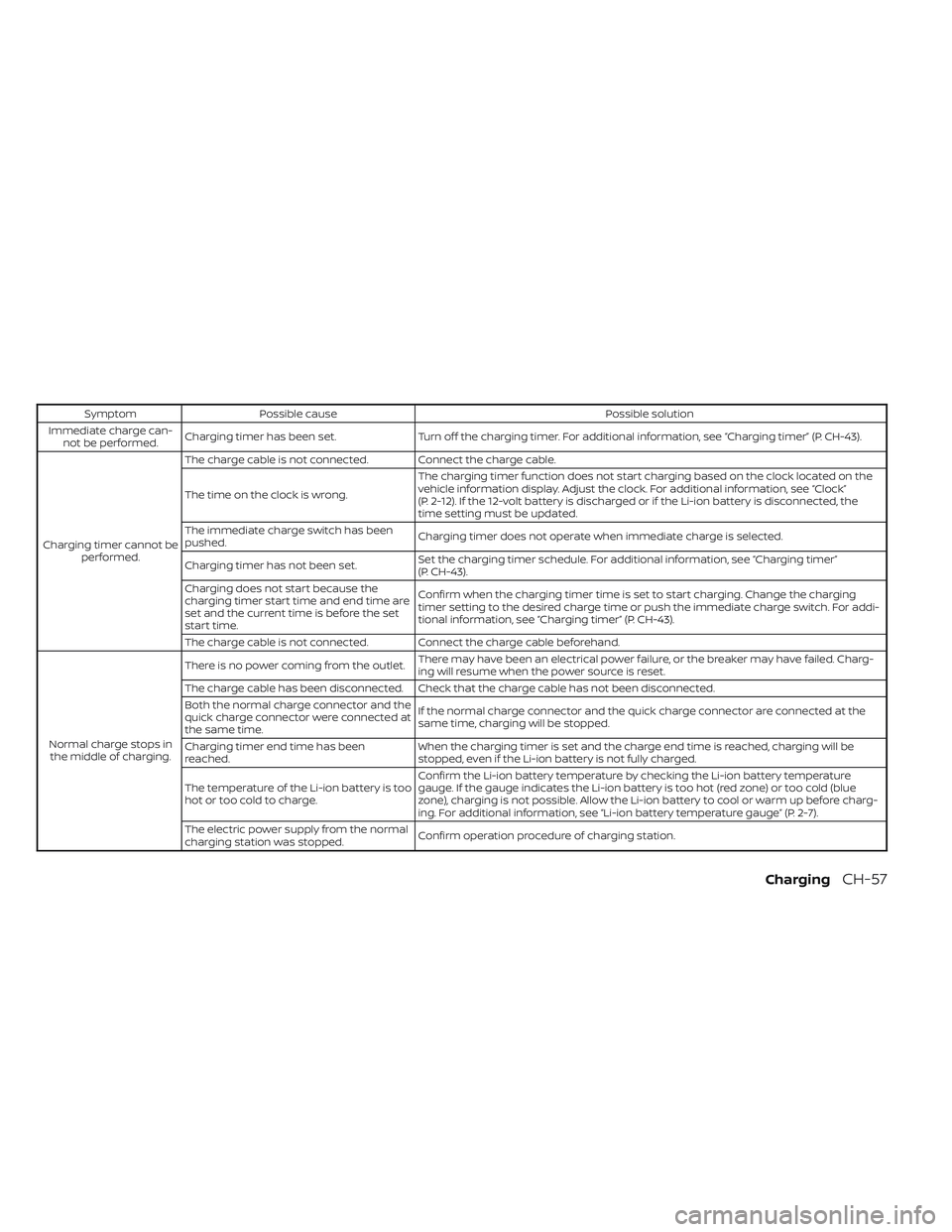
SymptomPossible cause Possible solution
Immediate charge can- not be performed. Charging timer has been set.
Turn off the charging timer. For additional information, see “Charging timer” (P. CH-43).
Charging timer cannot be performed. The charge cable is not connected. Connect the charge cable.
The time on the clock is wrong.
The charging timer function does not start charging based on the clock located on the
vehicle information display. Adjust the clock. For additional information, see “Clock”
(P. 2-12). If the 12-volt battery is discharged or if the Li-ion battery is disconnected, the
time setting must be updated.
The immediate charge switch has been
pushed. Charging timer does not operate when immediate charge is selected.
Charging timer has not been set. Set the charging timer schedule. For additional information, see “Charging timer”
(P. CH-43).
Charging does not start because the
charging timer start time and end time are
set and the current time is before the set
start time. Confirm when the charging timer time is set to start charging. Change the charging
timer setting to the desired charge time or push the immediate charge switch. For addi-
tional information, see “Charging timer” (P. CH-43).
The charge cable is not connected. Connect the charge cable beforehand.
Normal charge stops in the middle of charging. There is no power coming from the outlet.
There may have been an electrical power failure, or the breaker may have failed. Charg-
ing will resume when the power source is reset.
The charge cable has been disconnected. Check that the charge cable has not been disconnected.
Both the normal charge connector and the
quick charge connector were connected at
the same time. If the normal charge connector and the quick charge connector are connected at the
same time, charging will be stopped.
Charging timer end time has been
reached. When the charging timer is set and the charge end time is reached, charging will be
stopped, even if the Li-ion battery is not fully charged.
The temperature of the Li-ion battery is too
hot or too cold to charge. Confirm the Li-ion battery temperature by checking the Li-ion battery temperature
gauge. If the gauge indicates the Li-ion battery is too hot (red zone) or too cold (blue
zone), charging is not possible. Allow the Li-ion battery to cool or warm up before charg-
ing. For additional information, see “Li-ion battery temperature gauge” (P. 2-7).
The electric power supply from the normal
charging station was stopped. Confirm operation procedure of charging station.
ChargingCH-57
Page 109 of 612
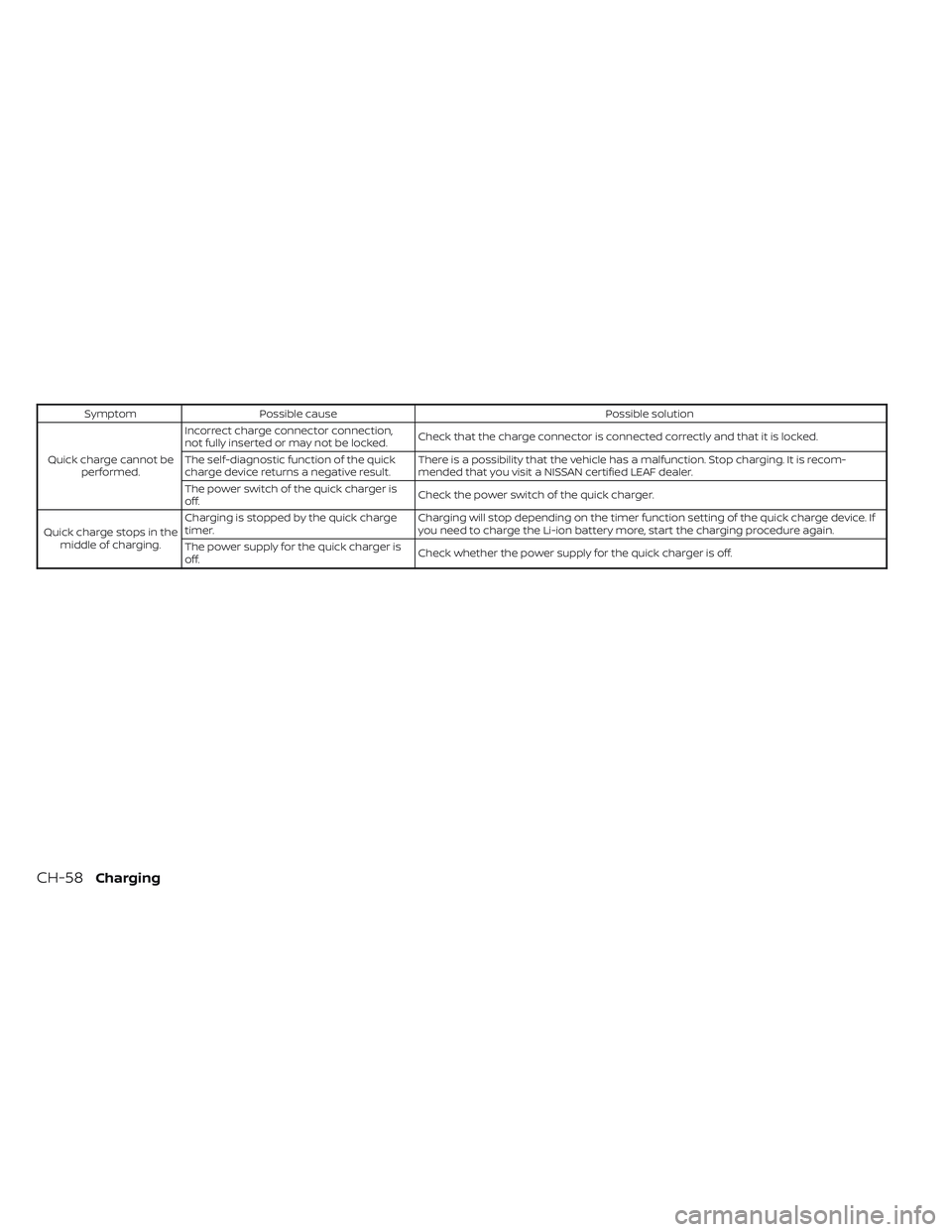
SymptomPossible cause Possible solution
Quick charge cannot be performed. Incorrect charge connector connection,
not fully inserted or may not be locked.
Check that the charge connector is connected correctly and that it is locked.
The self-diagnostic function of the quick
charge device returns a negative result. There is a possibility that the vehicle has a malfunction. Stop charging. It is recom-
mended that you visit a NISSAN certified LEAF dealer.
The power switch of the quick charger is
off. Check the power switch of the quick charger.
Quick charge stops in the middle of charging. Charging is stopped by the quick charge
timer.
Charging will stop depending on the timer function setting of the quick charge device. If
you need to charge the Li-ion battery more, start the charging procedure again.
The power supply for the quick charger is
off. Check whether the power supply for the quick charger is off.
CH-58Charging